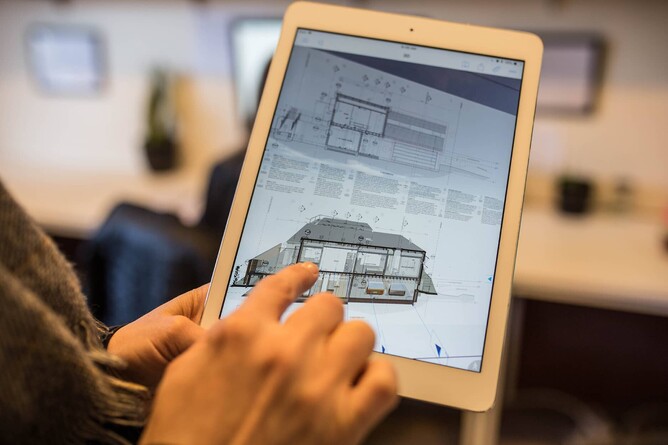While everyone dreams of a home that’s beautiful to behold and a joy to inhabit, energy efficiency is a more recent priority that’s growing in importance. That’s because rising energy costs must be balanced with the need to reduce carbon footprints — in short, it’s now critical to find ways to maximise your home’s efficiency.
In this article, we're sharing our top three strategies to significantly enhance your home’s energy efficiency, whether you’re embarking on a new build or upgrading your existing home.
What is an energy efficient home?
Energy efficient homes are designed to require minimal energy for heating, cooling, and operating appliances, while maintaining a consistently comfortable living environment. The goal of an energy efficient home is to achieve reduced energy consumption and lower emissions by incorporating the various strategies and technologies discussed in this article.
Thoughtful design and strategic decision-making are both key to achieving an energy efficient design.
Our top three factors for an energy efficient house
While there are numerous ways to make a home more energy efficient, there are three critical aspects that will provide big gains in efficiency. Maximising these three aspects will translate to lower operational costs and improved ROI.
1. Continuous highly insulated thermal envelope
A building’s thermal envelope comprises the insulated border of its habitable indoor areas and rooms. The thermal envelope includes walls, ceilings, floors, windows and doors. Garages, porches, attics with insulated roof spaces, and conservatories, are typically not considered part of the thermal envelope.
Ensuring the thermal envelope is completely insulated and free from gaps and thermal bridges results in a continuous thermal envelope. This will retain heat in winter and keep it out in summer, delivering year-round comfort with minimal need for additional heating and cooling.
Team Green Tip:
Ensure everything is insulated. Often a slab could be insulated only underneath, with no insulation around its perimeter — this is where you will lose the most heat!
2. Airtightness
Airtightness plays a huge role in a home’s energy efficiency. Even small gaps and cracks, or improper seals on doors, windows and other fixings, can lead to significant heat loss. This means more burden on your mechanical heating and cooling systems, which lowers efficiency and raises your carbon footprint.
Team Green Tip:
Airtightness can be tested via a variety of methods including a blower door test and thermal imaging. For a DIY hack, try taking a walk around your home's (closed) doors, locks, and windows with an incense stick — the movement of the smoke trails from the incense will reveal where air is leaking. Check out our airtightness article to learn more about how to achieve an airtight home.
3. Use shading and balanced HRV systems
Even the most efficient houses require some mechanical assistance for heating and cooling. Balanced Heat Recovery Ventilation (HRV), continuously refreshes the air in your home, whilst retaining the heat; a highly efficient approach. You might think of the HRV system as your home's lungs, allowing it to breathe a constant stream of fresh filtered air, free from mould and damp.
That said, in New Zealand we are still seeing new builds, particularly townhouses, that overheat and are far too reliant on mechanical cooling — often having just a single heat pump tasked with heating and cooling a two-storey townhouse.
Overheating issues arise when thoughtful orientation and the use of proper shading have been neglected during the design phase. You can hear more of Siân’s insight into overheating townhouses in this short interview with Newstalk ZB.
Team Green Tip:
Ensure there is adequate shading on north-facing windows and west-facing bedroom windows which will be subject to the hot afternoon sun. This will help to reduce the amount of heat entering your home and in turn, reduce the burden on your air con system.
Other ways to make a home more energy efficient
We’ve covered our top three strategies for a more energy efficient home, but there are other measures you can take. Here are more solutions to consider:
High performance windows
Upgrading to high-performance double- or triple-glazed windows will bring significant efficiency gains. This upgrade can mean the difference between needing a $60,000+ heating system and a $20,000 system with lower running costs — so it is money well spent. An accurate energy model will help determine the best use of your budget.
Efficient water heating
Outside of heating and cooling, water heating is one of the biggest energy demands on a household, so opting for the most efficient system you can for this task will go a long way to improving your home’s overall energy efficiency. Hot water heat pumps are often four times as efficient as a standard hot water heater, meaning you can reduce a typical bill by around three quarters.
Solar panels
While the upfront costs of solar panels have dropped, they’re still significant, but don’t overlook solar as a powerful long-term solution if your budget permits. Solar’s benefits include reducing your energy bills and carbon footprint, lessening your dependence on the grid, and adding long-term value to your home.
Smart home technology
Smart systems for thermostats, lighting and appliance management assist in optimising your energy usage and increasing efficiency. These technologies let you monitor and adjust your energy consumption in real time, reducing wastage and ensuring you're only using power when you need it. This not only translates to smaller energy bills but also tailors your home to your lifestyle and contributes to a lower carbon footprint.
Wrap up
Whether you’re building a new home or renovating, achieving high levels of energy efficiency takes careful planning, but the long-term rewards are worth it.
We recommend starting by understanding and implementing Passive House thinking, which will tie in with the strategies discussed in this article.
Whether you have a new or existing project, you can get deep insights into of your building’s energy efficiency by enquiring now to learn more about our consulting services — designed to deliver tangible and measurable impacts for residential and commercial owners.

